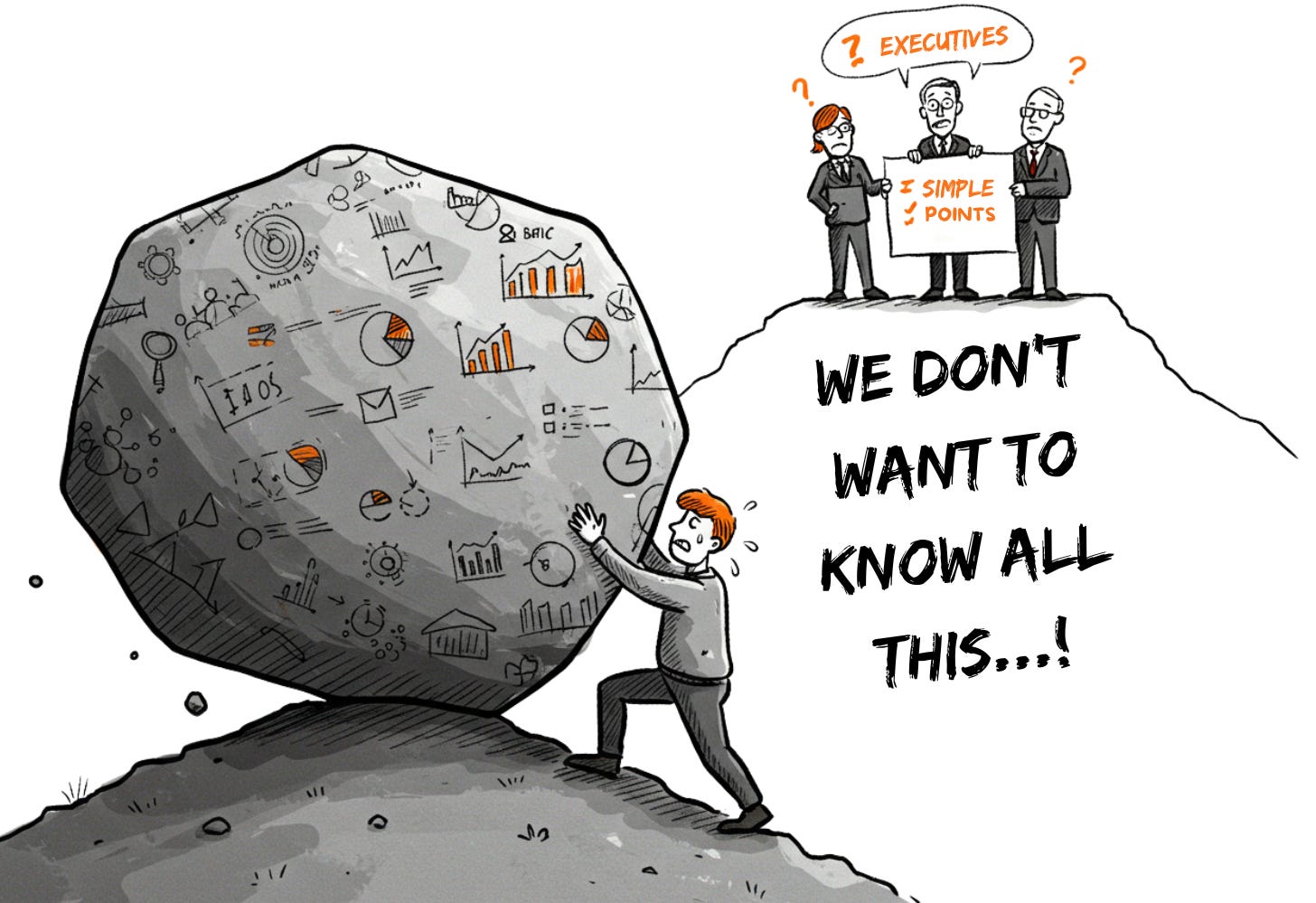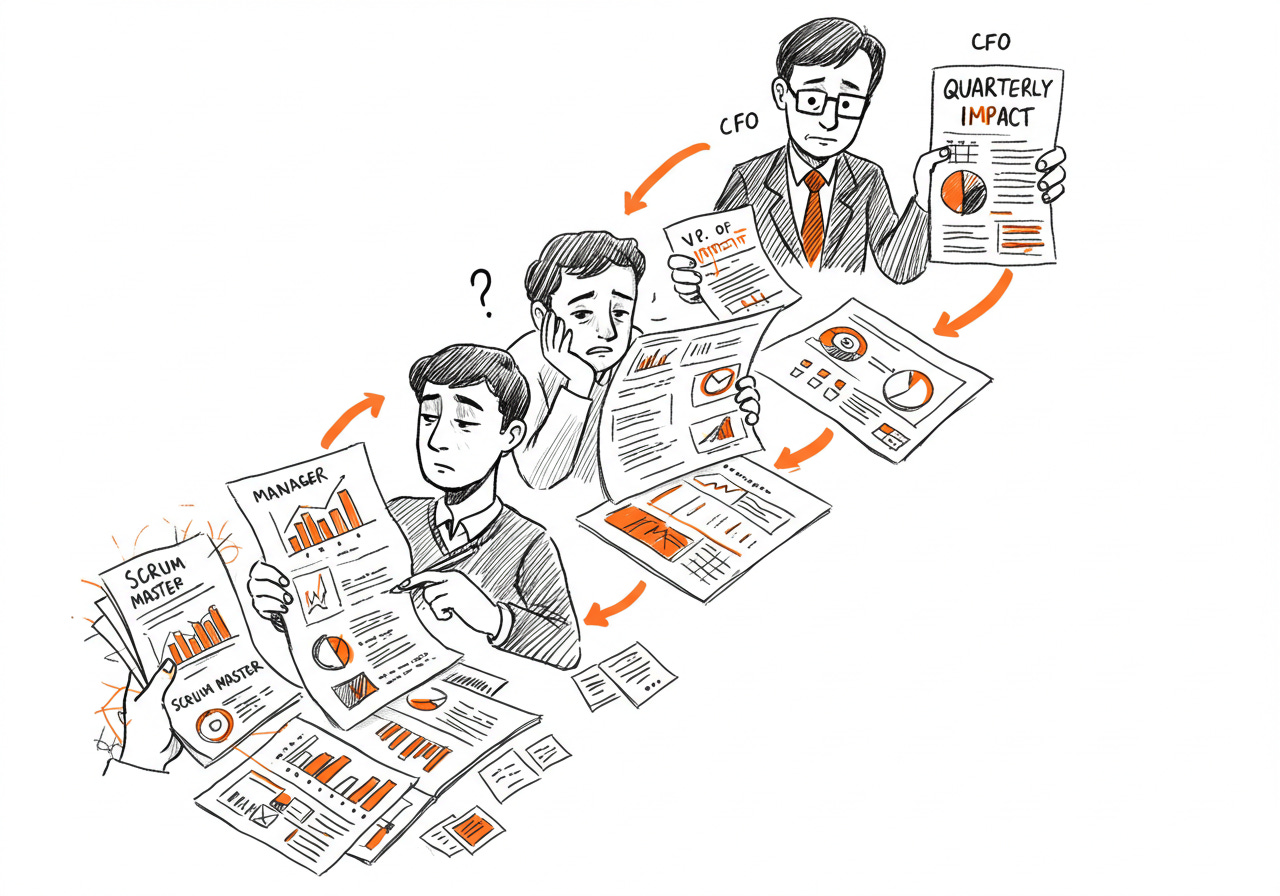Hello 👋, It’s Vibhor. Welcome to the 🔥 paid member only🔥 edition of Winning Strategy: A newsletter focused on enhancing product, process, team, and career performance. Many subscribers expense this newsletter to their Learning & Development budget. Here’s an expense template to send to your manager.
Here’s a question I get all the time:
“As a Scrum Master, how should I prepare a report for management and executives?”
This keeps coming up again and again.
It’s a great question and one that many Agile professionals struggle with. After all, the way we communicate progress “within” a team (burndown charts, sprint summaries, backlog updates) IS NOT what executives care about.
Executives (or any other report audience for that matter) specifically for Agile-based reports ARE NOT looking for a detailed step-by-step of your team’s daily work (well…unless it’s the team you’re preparing the report for).
They’re looking for insights that address their priorities:
business outcomes
risks
progress toward strategic goals
etc.
Just the other day, someone sent me this really long report she made.
She was pretty upset because after working super hard on it, her bosses barely looked at it.
"I spent days creating this comprehensive report," she said, "but the executives barely glanced at it. I don't understand - it has all the stuff I thought they needed."
I get it.
I remember feeling that same frustration years ago when I was new to the field.
I'd pour my heart into detailed Agile reports, including every velocity chart and burndown metric I could find, only to watch executives glaze over during presentations.
And let me tell you. That continued for a long time.
Until one day, when one of the executives (now my mentor, we are not in the same company anymore) pulled me aside and said: “Look, Vibhor, I don't need to know all the complicated stuff about how a watch works. I need to know what time it is."
THAT 🤯 blew my mind.
I was shocked and embarrassed at the same time.
The numerous hours I spent making those shiny reports… were a waste.
But… I learned my lessons.
In today’s post, I’ll cover the 7 Laws of Agile Reporting to help you create reports that resonate with your audience.
Let’s get started.
Related Posts
Law #1 - Who’s the Audience
Here's something that took me years to figure out.
The person asking for the report... isn't always the one who's going to read it.
Let that sink in for a moment.
Once, my VP of Engineering asked me for a detailed quarterly status report. I gave her exactly what she asked for, thinking she was the end consumer of the report.
But guess what?
That report wasn't for her.
It was going to the CFO, who needed just one thing: how our project delays were affecting the quarterly financial forecasts.
I’ve truly lost count of such incidents in my work life.
Nevertheless, here’s what you need to know: Reports OFTEN travel UP multiple levels of management, each with their own needs.
What your immediate manager needs...
What their manager needs...
What the executives need...
They're all different.
VERY different.
Understanding your report’s actual audience is the difference between your report landing in the "I'll read it later" folder (we all know what that means) versus becoming a valuable decision-making tool.
How to apply Law #1
Before you even open that spreadsheet or fire up Jira, understand:
Who will read the report? (Names and roles.)
What decisions are they making? (e.g. resource allocation, prioritization, risk mitigation)
What’s their tolerance for detail? (e.g. high-level progress, impediments, team health)
I wish someone had told me this when I started.
It would have saved me countless hours of creating beautiful reports that nobody ever read.
Note: At the end of the post, you can download a handy Notion template that will help you collect the right data for your Agile report.
Law #2: Identify report personas
Once you know who’s reading your report, the next step is to understand what they care about.
That’s where persona mapping comes in:
Build mini-profiles of your key readers so you can tailor the content to their specific needs.
3 most common personas you'll encounter:
1. Executive:
They care about strategic goals, ROI, and risk mitigation. They're thinking big picture:
"Is this initiative moving us toward our annual objectives?"
"What's the return on our investment?"
"What risks might derail our strategy?"
They rarely want to see burndown charts or story point completions. They need insights that connect team activities to business outcomes and financial impact.
2. Sponsor:
This might be a program manager or department head who wants program-level progress and cross-team dependencies. They're focused on questions like:
"Are all teams aligned?"
"Will delays in one area impact another?"
"Do we need to adjust resources between teams?"
Sponsors need visibility into how the various moving parts are working together, where bottlenecks exist, and how the overall program timeline is progressing.
2. Team Level
Your developers, testers, and designers are looking for “tactical” blockers and next steps. They need to know:
"What's holding us back?"
"What should I work on next?"
"Are we on track for our sprint goals?"
Their focus is immediate and practical, centred around daily and weekly execution rather than quarterly business outcomes.
Remember:
The most valuable report isn't the most comprehensive one, but the one that answers the specific questions your audience is asking.
ONE SIZE DOES NOT FIT ALL.
Law #3: Identify the metrics to include
Let’s get one thing straight: Every metric in your report needs a purpose.
If a metric doesn’t directly help someone make a decision, it doesn’t belong in the report.
Period.
Here’s how you can make sure your metrics actually matter:






